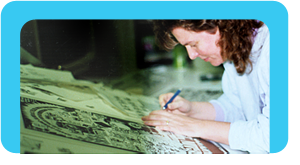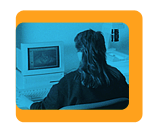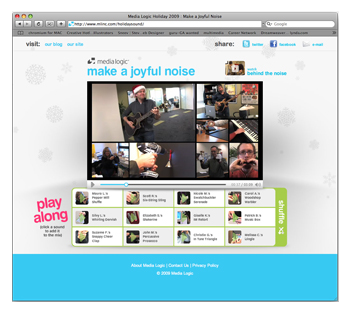Production 3.0 (sort of)
It’s like 1990 again, or is it? Those of us who have built our careers on the technical skills and software savvy required to build beautiful, effective means of communication have been indelibly changed by the overnight preeminence of social media and its impact on the marketing industry. Going social has forced the question: how will this new conversation-centric world affect my job?
 Some of us remember a similar transition about twenty years ago, when traditional graphic production (we’re talking galleys, xacto knives, spray mount, stat cameras and monstrous typesetting equipment) shifted into the computer age of desktop publishing. The tradesman-like skills of specialized dexterity, hand-eye coordination and endurance were replaced by amazing new tools – computer software, mouse and keyboard.
Some of us remember a similar transition about twenty years ago, when traditional graphic production (we’re talking galleys, xacto knives, spray mount, stat cameras and monstrous typesetting equipment) shifted into the computer age of desktop publishing. The tradesman-like skills of specialized dexterity, hand-eye coordination and endurance were replaced by amazing new tools – computer software, mouse and keyboard.  Making the jump into modern production with a crash course in Quark, Photoshop or Illustrator (to name just a few) was intense, initially terrifying, but ultimately amazingly empowering. Modern tools have facilitated faster, easier and more sophisticated production of visual communications.
Making the jump into modern production with a crash course in Quark, Photoshop or Illustrator (to name just a few) was intense, initially terrifying, but ultimately amazingly empowering. Modern tools have facilitated faster, easier and more sophisticated production of visual communications.
Gone were the days when it would take at least two people a full week to produce a single FSI. The specialties of typesetter and a paste-up artist morphed into one powerful resource: the graphic artist. Very much a blend of blue and white collar, graphic arts became a very rewarding way to apply one’s skills to “make” a living (not one you would like to see slip away into obsolescence). Fast forward to the Twenty-First Century, I would argue that our social world has upped the ante, and paved a new, wonderfully exciting avenue to further enhance that powerful resource.
 Creating visual ways to communicate with each other very much entails strategic thinking, time-sensitive decisions and troubleshooting (the very nature of software and hardware playing nicely together requires this). Enter multimedia. A powerful new suite of proficiencies can be adapted from the skill and talent required by traditional print-based graphic arts. Good layout sensibility can be called upon and applied to rich media, which in turn enhances blogs, or enriches web experience, for example. Editing web content through custom (or not) CMS can become a slight side step from editing brochures in Quark or InDesign. The point here is that all those wonderful abilities, like a keen eye for high-end color, superior layout and composition, and incredible deadline driven organizational skills, can be applied, and I would say effectively enhanced by stretching into the new media frontier.
Creating visual ways to communicate with each other very much entails strategic thinking, time-sensitive decisions and troubleshooting (the very nature of software and hardware playing nicely together requires this). Enter multimedia. A powerful new suite of proficiencies can be adapted from the skill and talent required by traditional print-based graphic arts. Good layout sensibility can be called upon and applied to rich media, which in turn enhances blogs, or enriches web experience, for example. Editing web content through custom (or not) CMS can become a slight side step from editing brochures in Quark or InDesign. The point here is that all those wonderful abilities, like a keen eye for high-end color, superior layout and composition, and incredible deadline driven organizational skills, can be applied, and I would say effectively enhanced by stretching into the new media frontier.
For me, unlike 1990, the demands and opportunities of this hot new transition is not nearly the stretch that Production 1.0 (pre-desktop) to Production 2.0 was. Computers as tools are now second nature, and we have all had to learn how to train ourselves on the fly. If we stay nimble and flexible, this new, infinitely networked world has unprecedented room for skill adaptation and unimagined growth.
 Recent Media Logic rich media projects such as chooseMVP.com and our own CCM model (referenced above) and Zeitgeist & Coffee videos, utilized Adobe After Effects as a composition and animation tool, Final Cut Pro, and Sound Edit Pro to edit and enhance the Rich Media experience, and employed Flash to create the video player to make it all work online. Then our own holiday card employed Final Cut Pro, Sound Edit Pro as well as Flash to create an interactive microsite with “play along” functionality.
Recent Media Logic rich media projects such as chooseMVP.com and our own CCM model (referenced above) and Zeitgeist & Coffee videos, utilized Adobe After Effects as a composition and animation tool, Final Cut Pro, and Sound Edit Pro to edit and enhance the Rich Media experience, and employed Flash to create the video player to make it all work online. Then our own holiday card employed Final Cut Pro, Sound Edit Pro as well as Flash to create an interactive microsite with “play along” functionality.




